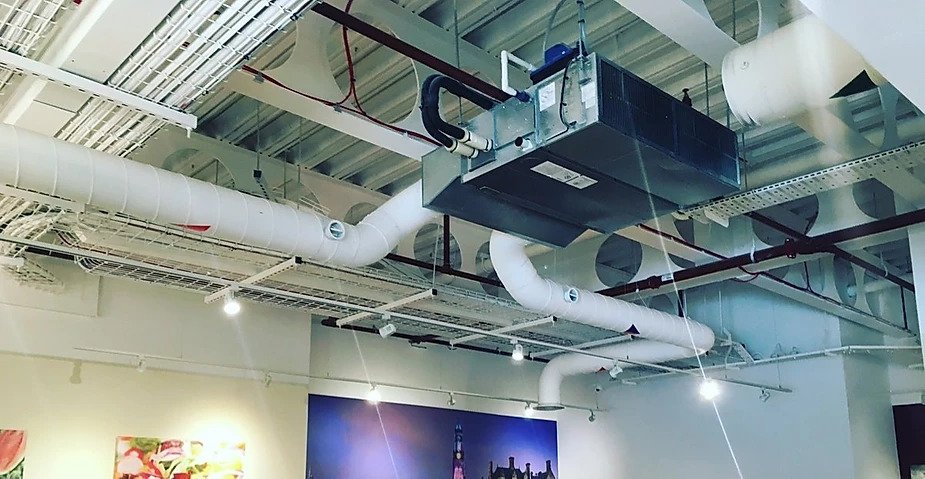We’ve tried here to distill the best and most socially-responsible advice, principally using excellent sources such as REHVA & BESA. Please refer to these sources for more detail.
1. Increase outdoor air ventilation to dilute indoor air aerosols.
-
Central HVAC systems with re-circulation facility should be operated on full outdoor (fresh) air
-
Outdoor air is unlikely to be contaminated
-
We are lucky that Europe is leaving the heating season and has not yet hit major cooling requirements
-
Switch off heat recovery systems (incl. wheel/enthalpy systems) where potentially contaminated extract air surfaces move into the supply air flow
-
Check that pressure relations at the recovery/re-circulation section are correct to avoid leakage of potentially contaminated exhaust air into the supply air flow
-
In non-mechanically ventilated buildings, open windows and/or doors in order to create “cross wind” from sunny/windy side of building and/or room to the shady/colder side of the building
2. Avoid re-circulation of room air by normal fans etc
-
Note that airborne droplet nuclei (<0.5µm) can remain airborne for a long time, whereas large droplets (>10µm – typical products of coughing or sneezing) usually fall to the surface quickly
-
See the video clip from NHK on small droplet nuclei.
3. Do not operate locally recirculating air conditioning equipment (If possible), such as fan-coil units and induction units
-
These systems have typically very low efficiency filtration which will be minimal use against small droplet nuclei
-
If cleaning and disinfection is required in a room space for coronavirus reasons, then the associated room air recirculating equipment and its ductwork must be included.

-
Filters should however be replaced according to normal maintenance schedules, to ensure normal ventilation airflow volumes and to avoid over-loading and ‘blow-through’
-
Indoor air filters of any efficiency grade will not become more efficient by being changed – however over-loading should still be avoided.
-
When changing filters, good hygiene practice – i.e. PPE and bagged disposal is especially important
5. Viruses, unlike bacteria and fungi, cannot thrive (i.e. multiply) outside the body of a living organism. There is uncertainty over how long viral fragments can remain active and infectious on various surfaces – with scientific estimates ranging from a few hours on textiles up to maximum 10 days on steel and glass.
-
Where it is necessary to operate potentially coronavirus-contaminated HVAC systems, or to put them back into operation within short periods (say <10 days), then they should be cleaned and disinfected.
6. Duct cleaning in itself is not useful as a method of controlling the spread of viruses among a population in a building, however where ductwork is a transmission site, or provides a risk of re-entrainment of active viral fragments, then cleaning and disinfection is recommended.
-
Cleaning can be important to ensure that HVAC systems perform as designed with airflow rates to properly ventilate the building.
7. Cleaning procedures – as always – should ensure careful control of contamination by means of e.g. HEPA filtration of extractor and vacuum air, cleaning at under-pressure and suitable PPE
8. Disinfection of typically dirty HVAC surfaces without physical cleaning to remove existing particulates/dirt is very likely to be sub-optimal
9. Disinfectant products should be carefully evaluated for efficiency against viruses. No service providing company should use any product without approval from the client. Failed disinfection treatment could in many circumstances be more dangerous than no treatment
-
Guidance has been issued based on more general virucidal efficacy, particularly against coronaviruses. The European Chemicals Agency provides information here. The US EPA provides guidance here, and National governments may also provide guidance.
-
Great care should be taken to prevent injury to operatives carrying out the disinfection and occupants of the building
10. Disinfectant usage is always a balance between the effectiveness and usefulness of the treatment and the potential costs such as damage or injury, as well as pure economic cost.
-
For HVAC ductwork, biocidal products which require no rinsing are generally favoured due to the risk of leakage of rinse-water. For these reasons oxidising products such as stabilised chlorine dioxide or hydrogen peroxide which decay harmlessly, or alcohol-based products which evaporate, are often employed.
-
Care must be taken to avoid corrosion and fire risks respectively, as well as general application controls such as PPE and room/building evacuation.
-
Typically fine mist nebulising aerosol generators are the preferred method of application in order to achieve more complete surface wetting.
11. Consideration could also be given to the use of air purifiers, using minimum-HEPA filtration, in order to reduce airborne contaminant loads in ambient air where people work and many people come-and-go.
Knowledge and understanding of coronavirus is constantly growing and we would welcome contributions from people in the field.
We look forward to posting more updates and e.g. advice regarding ventilation hygiene business over the coming days
0 Comments